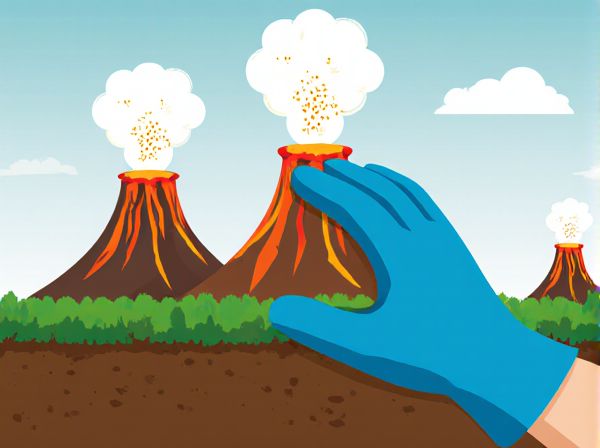
Mulch volcanoes vs flat mulching Illustration
Mulch volcanoes, which involve piling mulch high against tree trunks, can trap moisture and cause bark decay, leading to tree health issues. Flat mulching spreads mulch evenly around the base, promoting better moisture retention, weed suppression, and root protection without risking trunk damage. Proper flat mulching ensures optimal tree growth and reduces the chances of pest infestations and diseases compared to mulch volcanoes.
Table of Comparison
| Feature | Mulch Volcanoes | Flat Mulching |
|---|---|---|
| Definition | Mulch piled around tree bases forming a volcano shape | Mulch spread evenly flat across the soil surface |
| Moisture Retention | Moderate, risk of moisture trapping near trunk | High, enhances soil moisture uniformly |
| Root Health | Can cause root rot, girdling roots | Promotes healthy root growth and aeration |
| Pest Risk | Increased risk due to mulch contact with trunk | Lower risk, mulch kept away from trunk |
| Soil Temperature Regulation | Less effective, heat buildup near trunk | Effective, stabilizes soil temperature |
| Best Use | Avoided, not recommended by arborists | Recommended for trees, shrubs, and garden beds |
Understanding Mulch Volcanoes vs Flat Mulching
Mulch volcanoes occur when mulch is piled up around the base of a tree trunk, restricting airflow and trapping moisture, which can lead to bark decay and pest infestation. Flat mulching involves spreading mulch evenly in a donut shape around the root zone, promoting healthy root growth and improved soil moisture retention without harming the tree. Understanding the differences between mulch volcanoes and flat mulching is crucial for maintaining tree health and preventing common arboricultural issues.
What Is a Mulch Volcano?
A mulch volcano is a gardening technique where mulch is piled up in a cone shape around the base of a tree, resembling a small volcano. This practice can trap moisture and heat against the tree trunk, potentially causing bark rot and fungal infections. Flat mulching, by contrast, involves spreading mulch evenly in a flat layer around the tree, preventing moisture buildup directly against the trunk and promoting healthier root growth.
The Science Behind Flat Mulching
Flat mulching improves soil health by maintaining consistent moisture and temperature levels, promoting beneficial microbial activity essential for nutrient cycling. Unlike mulch volcanoes, which can cause moisture buildup and root suffocation, flat mulch layers prevent fungal growth and root rot by allowing proper air circulation. This method enhances soil structure and supports plant root systems, resulting in healthier and more resilient vegetation.
Dangers of Mulch Volcanoes Around Trees
Mulch volcanoes create excessive moisture and air restriction near tree trunks, leading to bark decay, fungal infections, and increased susceptibility to pests. This improper mulching technique traps heat and moisture against the trunk, causing root suffocation and girdling that can eventually kill the tree. In contrast, flat mulching maintains proper soil aeration and moisture balance, promoting healthy root growth and reducing the risk of long-term tree damage.
Benefits of Proper Flat Mulching Techniques
Proper flat mulching techniques enhance soil moisture retention and temperature regulation, promoting healthier root development and plant growth. Unlike mulch volcanoes, which can trap moisture against tree trunks causing rot and pest infestations, flat mulching minimizes these risks by evenly distributing organic material away from the base. This method also improves soil aeration and nutrient absorption, resulting in stronger, more resilient plants.
Common Myths About Mulching Trees
Mulch volcanoes, often formed when mulch is piled around the tree trunk, can suffocate roots and invite pests, contrary to the belief that they protect trees. Flat mulching, with a 2-4 inch layer spread evenly over the root zone, supports healthy growth by retaining moisture and regulating soil temperature. The myth that thick mulch mounds improve tree health is debunked by arborists, who recommend avoiding mulch piled against the trunk to prevent disease and decay.
Visual Differences: Mulch Volcanoes and Flat Mulch
Mulch volcanoes create a conspicuous mound of mulch around tree bases, which can trap moisture and potentially cause bark decay or pest infestations. Flat mulching, in contrast, spreads mulch evenly and thinly across the soil surface, promoting better moisture retention and root health without suffocating the tree trunk. The visual difference is stark: mulch volcanoes form prominent, unnatural hills, while flat mulch provides a clean, smooth, and natural groundcover appearance.
Step-by-Step Guide to Flat Mulching
Flat mulching offers a streamlined method for soil improvement by spreading organic materials evenly over the ground, promoting moisture retention, and suppressing weeds without disturbing the soil structure. Unlike mulch volcanoes that pile material against tree trunks, flat mulching prevents trunk rot and pest infestations by maintaining proper air circulation. To execute flat mulching effectively, start by clearing the area of weeds, apply a 2-4 inch layer of organic mulch such as wood chips or compost, and replenish the mulch annually to sustain soil health and plant vitality.
Best Practices to Avoid Mulch Volcanoes
Avoid piling mulch against the tree trunk to prevent mulch volcanoes, which can cause moisture buildup and lead to bark decay or pest infestation. Apply a 2 to 4-inch layer of mulch evenly around the tree, extending to the drip line but keeping it several inches away from the trunk base. Regularly inspect and replenish mulch to maintain appropriate depth and promote healthy root growth while preventing disease.
Long-Term Impact on Plant Health & Soil Quality
Mulch volcanoes trap moisture against tree trunks, promoting bark decay and pest infestations, which harm plant health over time. Flat mulching evenly distributes organic matter across the soil surface, enhancing nutrient absorption, improving soil aeration, and supporting beneficial microbial activity. Consistently applied flat mulch fosters stronger root development and long-term soil fertility, crucial for sustainable plant growth.
Mulch volcanoes vs flat mulching Infographic

 gardendif.com
gardendif.com